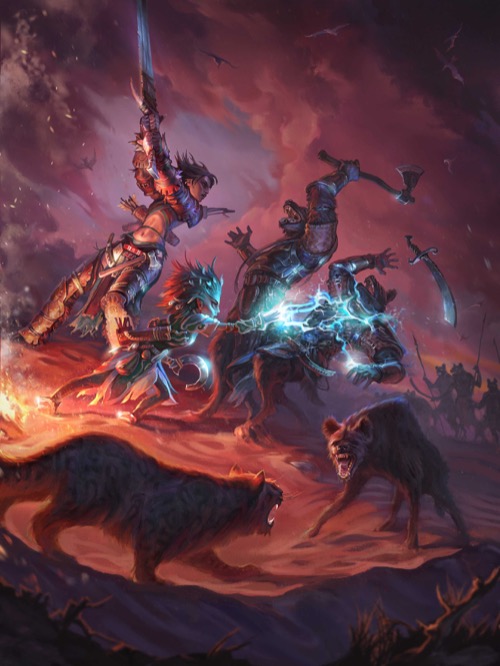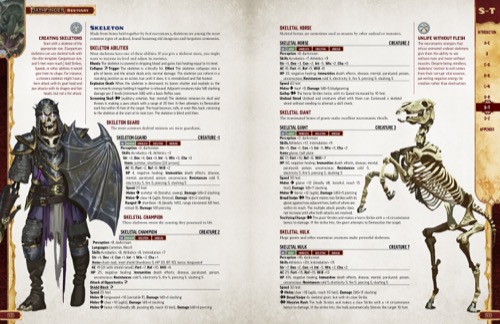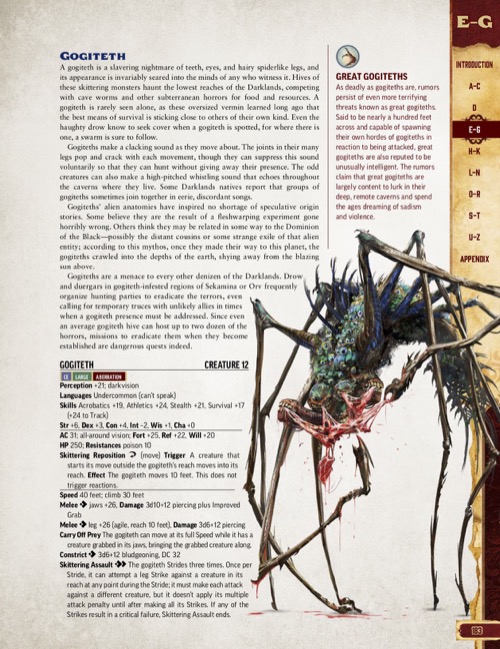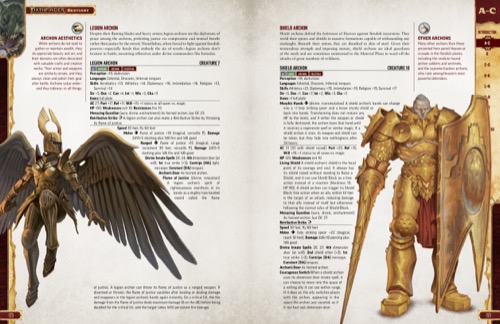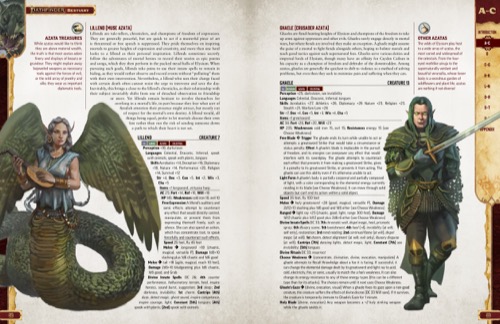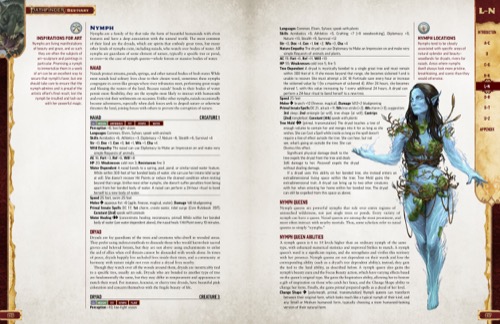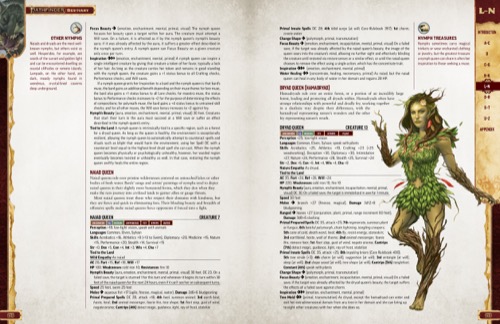This week, we’re going to take a look at the tools the new edition provides the GM to tell awesome stories full of interesting foes and hazards as well as plenty of opportunity to shine the spotlight on the PCs and show off how incredible the PCs are!
But before I get too mired into details of the rules, I want to talk about the high-quality overall GM advice in the book. For instance, my favorite bit of GM advice is this section in Gamemastering on adjudicating the rules, where we flat out tell you the underlying principles so you can design improvised rules on the fly!
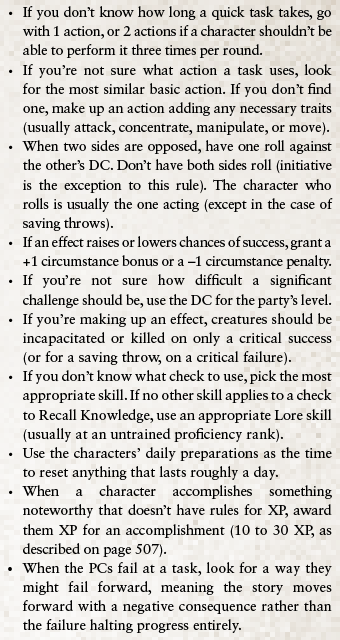
There’re tips on encounter, session, adventure, and campaign management as well! One useful new tool we added was the Pathfinder baseline, which essentially explains a baseline assumption for edgy content. Whether you want to follow it or not is totally up to your group. It’s a conversation starter; the baseline determines what you should expect from our published adventures, and we’ll tell you if there’s an exception. Similarly, for a home game, if you read the baseline and want to add or remove restrictions (or scrap it entirely!) you now know that you should talk to the rest of your group first. Lack of communication often arises when everyone has their own baselines and assumes everyone shares theirs.
But you want some hard rules, right? We have rules for encounters, exploration, and downtime, as well as rules for all sorts of environmental effects, natural disasters like volcanic eruptions, and hazards like haunts and traps. For a quick taste of these before we move on, take a look at these temperature effects. Unlike First Edition, they aren’t based on the legacy Pacific Northwest sensibilities where a day of summer back home on the East Coast would kill me from nonlethal damage!

For our in-depth look, let’s start with guidelines for skill DCs! You might’ve seen the simple DCs before from Jason’s spoilers, but we have those, as well as a level by level DC table for tasks against something of that level, which you can adjust by 2, 5, or 10 if it’s particularly easy or hard. For instance, learning a 6th level spell or identifying level 11 monster is DC 28, but uncommon spells or monsters are DC 30, and rare spells or monsters are DC 33. You’ll also notice these DCs are much easier to make than before, thanks to playtest guidance through a series of other numbers, we’ve alighted on a strong set that can help show off how amazing your PCs are!
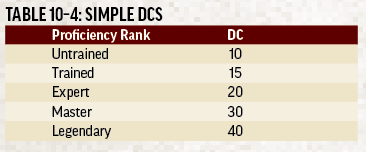
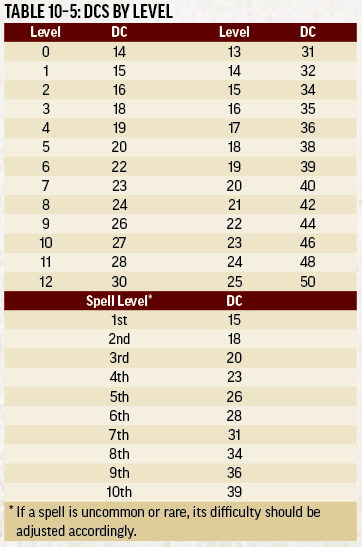
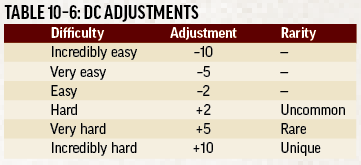
Also, by popular playtester demand, we can a table of typical skills to identify monsters.
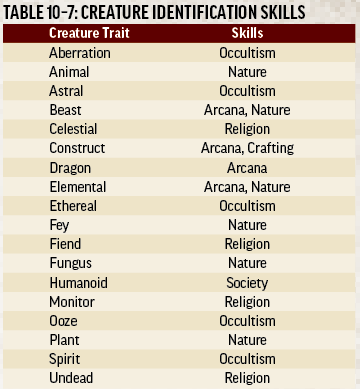
Speaking of monsters! The Bestiary contains friends and foes of all sorts, from the classic to the brand new. Take a look at the skeleton for a moment.
You can build any skeleton you need at lightning speed, and add fun special abilities like exploding bones, throwing heads, or collapsing into piles of bones! Plus check out the lore sidebar about vital essence; playtesters demanded to see more of the four magical essences in the foreground, so they’re coming out to play everything once in a while!
What about a newcomer? The gogiteth is a gross skittery critter with a lot of fun movement and grapple abilities. Can you still have an interesting encounter against a purely melee 12th-level foe when the PCs have so many special options at their fingertips? The gogiteth wants to say “yes” but it has you in its mouth and is currently skittering around, so you’ll have to take my word for it.
To close out our monster review, let’s take a look at some friendly creatures…
Whoops, some gremlins in the gears! Those aren’t friendly at all. Each gremlin has a special way that they make life miserable for those around them, except perhaps the incomplete mitflits, who are just themselves miserable little guys. Maybe you can help give them a social order and teach them that self-loathing isn’t the answer? If you think like that, you might like these actually friendly allies.
Each archon represents a particular virtue, with justice and courage shown here. The legion archon takes justice into its own hands (literally) with some powerful offense, while the shield archon explores courage as the virtue of bravery to sacrifice yourself for others and stand in the thick of things. And if you’re sharp-eyed, you now know one of the other archons in the book as well! Meanwhile, on the chaotic side…
Azatas each represent a freedom. Ghaeles stand for the freedom to bear arms against oppression, and they’re energy form and energy focus have a revamp to fit their concept and be a bit more interesting; take a look! Lillends are the embodiment of freedom of expression and a great summon for a party looking for a quick bard. Plus, they are a great choice for your bard’s muse. The other great option? Take a look at the nymph!
The nymph entry gives you not only low-level nymph allies like the naiad or dryad, but also tools to build powerful nymph queens like Myriana or Svevanka from Rise of the Runelords or Nyrissa from Kingmaker, with special rules for being a bard’s muse! This should make the entries for classic nymphs like the lampad much more interesting—note the intriguing and new-to-Pathfinder hesperides mentioned in the sidebar as well!
To close off, a personal note: I’m most of the way through book five of the War for the Crown Adventure Path, which I’m running in Second Edition. GMing it has been a joy; preparing and running have been much easier than when I ran Jade Regent or Rise of the Runelords in First Edition, even including the effort of converting the adventure. Other Paizo community members running in the playtest have noted this as well, including community member Ediwir, who is running War for the Crown in both First Edition and the playtest at the same time to compare. If you’ve ever wanted to GM Pathfinder before but it just looked daunting, Second Edition is the perfect time to give it a shot! You’ll have all these tools at your fingertips to make life easier, and everyone’s starting out too, so there will be tons of community support and goodwill, as well as more than a little patience for mistakes. I hope you’ll join me and give running a game a shot. If you do, what are you most excited to run first? The Age of Ashes Adventure Path? The Fall of Plaguestone? Pathfinder Society adventures? Something special you’re brewing up at home? Let me know in the comments below!
Mark Seifter
Designer
Mastering Pathfinder
Monday, July 22, 2019

